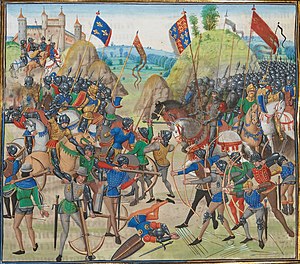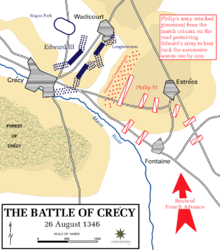Battle of Crécy
50.25755555561.90094444444Coordinates: 50° 15′ 27.2″ N, 1° 54′ 3.4″ E
Battle of Crécy
Part of: Hundred Years War

Illumination in the Chroniques of the historian Jean Froissart on the Battle of Crécy
Battles of the
Hundred Years War
(1337-1453)
Phase 1 1337-1386
Channel and Flanders (1337-1340): Cadzand - Arnemuiden - Channel - Sluis
Chevauchées of the 1340s: Saint-Omer - Auberoche
Edward III campaign (1346/47): Caen - Blanchetaque - Crécy - Calais
War of the Breton Succession (1341-1364): Champtoceaux - Brest - Morlaix - Saint-Pol-de-Léon - La Roche-Derrien - Tournament of the Thirty - Mauron - Auray.
France's Allies: Neville's Cross - Les Espagnols sur Mer - Brignais
Chevauchées of the 1350s: Poitiers
Castilian Civil War & War of the Two Peter (1351-1375): Barcelona - Araviana - Nájera - Montiel
French counter-offensive: La Rochelle - Gravesend
Wars between Portugal and Castile(1369-1385): Lisbon - Saltés - Lisbon - Aljubarrota
2nd phase 1415-1435
Henry V campaign (1415): Harfleur - Azincourt
Battle for Northern France: Rouen - Baugé - Meaux - Cravant - La Brossinière - Verneuil
Joan of Arc and the turn of the war: Orléans - Battle of the Herrings - Jargeau - Meung-sur-Loire - Beaugency - Patay - Compiègne - Gerberoy
Phase 3 1436-1453
French victory: Formigny - Castillon
The Battle of Crécy on 26 August 1346 marked the beginning of the Hundred Years' War in continental Europe. In this battle near the present-day town of Crécy-en-Ponthieu in the Somme department, the armies of Edward III of England and Philip VI of France faced each other. Edward III won a decisive victory.

Tactical representation of the course of the battle
Consequences of the battle
The valuation of a 'decisive victory of Edward III' at Crécy was not shared by the US historian Barbara Tuchman: "The pursuit [... of the] defeated enemy" did not take place. "Fascinated by the spoils of their victory, the English spent the next day identifying and counting the dead." Then they "marched along the coast to attack Calais [...] and dug in for a siege that was to last over a year. [...] The battle for Calais, lasting from August 1346 to August 1347, had enfeebled the troops and depleted the reserves. Provisions, horses, arms had to be fetched from England, where the confiscation of grain and cattle was causing economic hardship and the takeover of merchant ships was ruining wool exports and reducing tax revenue. [...] The new bridgehead in France had no consequences except a truce that lasted until 1351." The English "had gloriously won a naval battle (the naval battle of Sluis, 1340) and a field battle, and yet were far from conquering France or its crown. [...] Crécy and Calais guaranteed that the war would go on - but not immediately, for in 1347 Europe stood on the brink of the deadliest catastrophe in recorded history." This refers to the plague called the "Black Death" by later chroniclers.
Reception
The battle is described in the novels The Gates of the World by Ken Follett, The Archer by Bernard Cornwell, and Legends of War: The Bloody Sword by David Gilman. Some of the main characters take part - some actively, some passively - in the battle. The Battle of Crécy is also mentioned in the story The Last Adventure (published 1953) by Heimito von Doderer in a conversation that the protagonist, the Spanish knight Ruy de Fanez, has with his squire Patrik about the English longbows. In the film Black Death, set in 1348 at the time of the plague epidemic, a mercenary also recounts his participation in the battle.
Furthermore, the comic Crécy by Warren Ellis and Raulo Caceres tells the story of the Battle of Crécy from the point of view of an English archer.
Questions and Answers
Q: When did the Battle of Crécy happen?
A: The Battle of Crécy happened on 26 August 1346.
Q: Where did the Battle of Crécy take place?
A: The Battle of Crécy took place near Crécy in northern France.
Q: Which side won the Battle of Crécy?
A: The smaller English army won against the much larger French army in the Battle of Crécy.
Q: What made the Battle of Crécy an important battle in the history of warfare?
A: New tactics and weapons used by the English army, particularly the longbow, make the Battle of Crécy an important battle in the history of warfare.
Q: How did the English use the longbow to win against the French knights in the Battle of Crécy?
A: The longbow was a faster weapon to fire than the French and Genoan crossbow and could send arrows farther than the crossbow could and with more force. The English used the longbow to shoot the French knights from a distance, which gave them an advantage.
Q: What was the most important part of an army during the Middle Ages?
A: During the Middle Ages, knights had been the most important part of an army.
Q: What do some historians call the Battle of Crécy?
A: Some historians call the Battle of Crécy the beginning of the end of chivalry because of the change in tactics and weapons that occurred during the battle.
Search within the encyclopedia